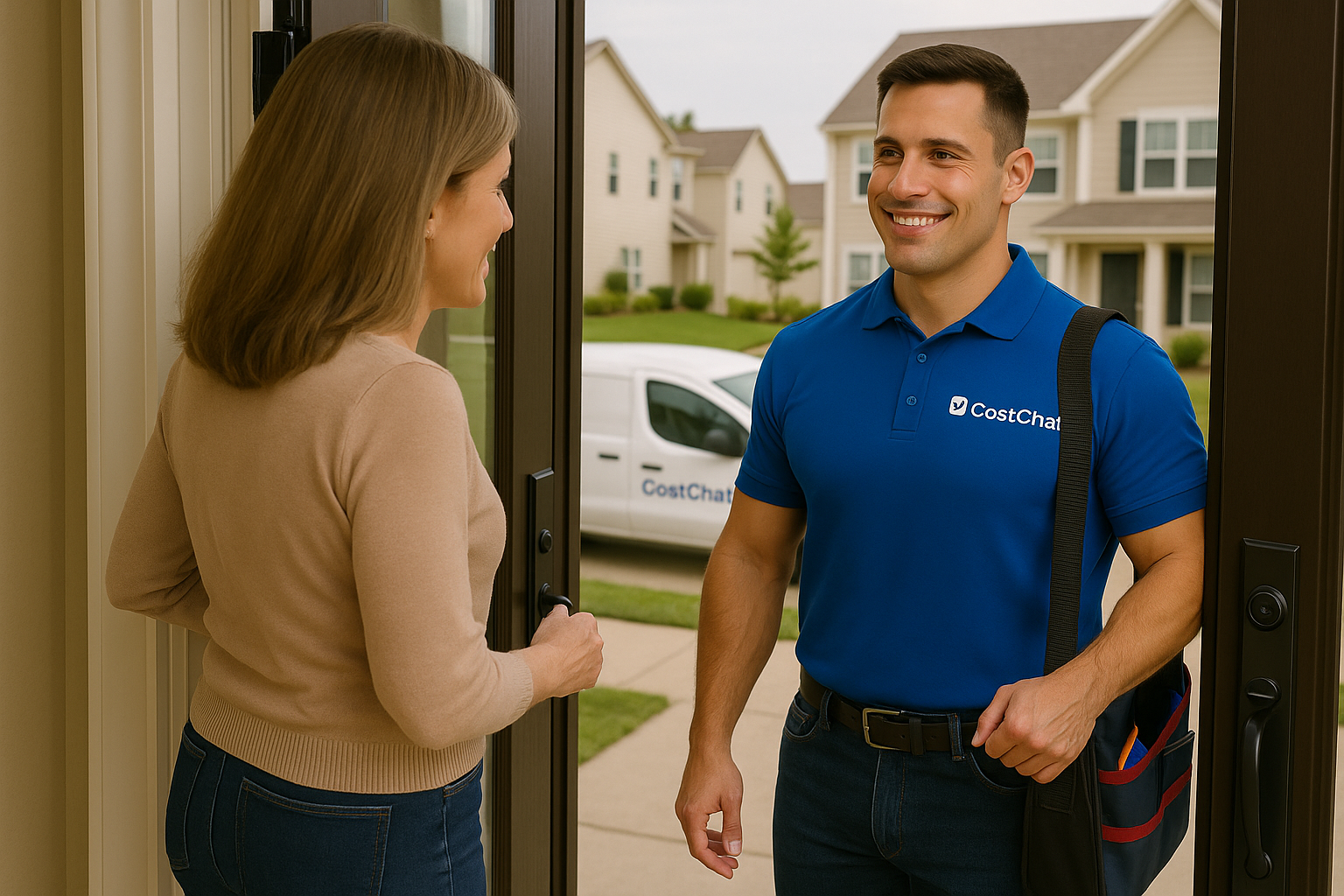
Find Top Local Trenchless Sewer Repair Providers in Springfield, MA – Book Today
How to Hire Top Rated Trenchless Sewer Repair Pros in Springfield, MA
Get a Free Online Estimate
Share your project details and receive a free online estimate from top-rated local pros. Not sure what it should cost? Check our Cost Guide.
Get EstimateCompare Local Quotes
View multiple free online quotes side by side. Use our Price Guide to understand labor rates, materials, and service fees before you hire.
Compare NowBook Best Top Rated Pros
Choose a licensed pro with confidence. Lock in your date after reviewing your free estimate and browsing our expert Cost Guide for peace of mind.
Book NowDid You Know?
74% ⚠️
of homeowners face surprise costs and delays — mostly from hiring unvetted pros. Don’t risk it. Hire trusted experts today.
Hire Top Rated & Verified ProsWork With Verified & Trusted Pros 🛡️
Save time, avoid costly mistakes, and experience reliable, top-quality service for every home project. Book now for priority scheduling and peace of mind.
Hire a Top Rated ProGet Instant Online Estimate of Trenchless Sewer Repair in
🔎 CostChat Online Cost Estimator
Describe your project and location to get an instant estimate.
Springfield, MA Trenchless Sewer Repair: Your Comprehensive Homeowner's Guide
As a homeowner in Springfield, MA, you understand the importance of a well-maintained home. You cherish the comfort and reliability that comes with a functioning plumbing system. However, aging infrastructure, common in many of our historic neighborhoods, can present unexpected challenges. When your sewer line needs attention, the thought of disruptive excavation can be daunting. This guide is designed to provide Springfield residents with clear, actionable information about trenchless sewer repair, offering a modern, less invasive solution that respects your property and your peace of mind.
Table of Contents
- Introduction
- Springfield, MA's Unique Trenchless Sewer Repair Landscape: Why Local Expertise Matters
- Neighborhood Hotspots: Micro-Local Trenchless Sewer Repair Risks & Solutions
- Common Problems & Triggers for a Professional Trenchless Sewer Repair Call
- Navigating Springfield, MA's Regulations: Permits, Code & Professional Licensing
- Maximize Your Savings: Springfield, MA Trenchless Sewer Repair Rebates & Incentives
- Choosing Your Springfield, MA Trenchless Sewer Repair Solution
- The Cost of Trenchless Sewer Repair in Springfield, MA
- Hiring Springfield, MA's Top-Rated Trenchless Sewer Repair Professional: Your Action Plan
- FAQs About Trenchless Sewer Repair in Springfield, MA
Springfield, MA's Unique Trenchless Sewer Repair Landscape: Why Local Expertise Matters
The Age & Character of Springfield, MA Homes: A Trenchless Sewer Repair-Related Time Capsule
Springfield, MA, with an estimated population of around 153,000 residents across 33 square miles, boasts a rich architectural heritage. Many homes were built before 1950, reflecting styles like Colonial, Victorian, and early 20th-century Craftsman and Bungalow. This historical housing stock, particularly in neighborhoods like Forest Park, presents specific challenges for underground infrastructure, including sewer lines.
- Pre-1950 Homes: Often feature cast iron or clay sewer pipes. These materials are susceptible to root intrusion, corrosion, and cracking due to age and soil settlement, common issues in older urban areas.
- Mid-Century Homes (1950s-1970s): May have Orangeburg pipes or early forms of PVC. Orangeburg pipes are known for their tendency to collapse, especially under the pressure of Springfield's freeze-thaw cycles.
- Modern Homes (Post-1980s): Typically utilize PVC or ABS, which are more durable but can still be affected by improper installation, heavy loads, or significant ground shifting.
The presence of older, potentially deteriorating sewer lines makes trenchless repair methods an attractive and often necessary solution for many Springfield homeowners seeking to avoid the extensive disruption of traditional dig-and-replace methods.
Springfield, MA's Environmental & Utility Factors & Climate Impact on Your Sewer Line
Understanding Springfield's environment is key to maintaining your sewer lines. The Springfield Water and Sewer Commission sources water from reservoirs, treating it to ensure safety. While the water is moderately hard, contributing to potential mineral buildup in supply lines, the primary concern for sewer lines is the external environment.
- Climate: Springfield experiences a humid continental climate with cold, snowy winters and warm summers. The common freeze-thaw cycles from late fall through early spring can exacerbate existing pipe weaknesses, causing expansion, contraction, and further cracking or joint separation in older sewer lines. Heavy seasonal rainfall can also contribute to soil saturation and movement, potentially stressing underground pipes.
- Soil Conditions: Soil movement, possibly intensified by freeze-thaw cycles and natural settlement, can shift pipe alignments, leading to leaks or breaks. This is a significant factor for underground infrastructure like sewer lines.
Trenchless sewer repair methods are particularly well-suited to mitigate these environmental impacts by creating a new, durable pipe within the old one, offering resilience against these forces.

Experiencing sewer line issues? Discover a less disruptive solution for your Springfield home.
Request a QuoteNeighborhood Hotspots: Micro-Local Trenchless Sewer Repair Risks & Solutions
Springfield's diverse neighborhoods present unique challenges for sewer infrastructure, often tied to their age and development history.
- Forest Park Area: Known for its historic homes, many built before 1950. These properties often have older cast iron or clay sewer lines prone to root intrusion and corrosion. Trenchless pipe lining is an excellent solution here to preserve the character of these homes and landscapes.
- South End & Other Older Districts: May feature a mix of housing stock, including some properties with potentially problematic Orangeburg pipes or clay pipes that have deteriorated. Trenchless pipe bursting can be ideal for replacing collapsed lines in these areas, offering a cost-effective and less disruptive alternative to full excavation.
- East Forest Park & Sixteen Acres: While some homes are newer, areas with older infrastructure may still face issues. Understanding the specific vintage of pipes is crucial. Trenchless repairs can be applied regardless of whether the original pipe is clay, cast iron, or even Orangeburg.
Local knowledge helps pinpoint the most likely issues based on your neighborhood, guiding the most effective trenchless sewer repair strategy.
Common Problems & Triggers for a Professional Trenchless Sewer Repair Call
Several signs indicate your sewer line may be failing and requires professional attention, especially concerning in Springfield's older housing stock.
- Slow Drains or Gurgling Sounds: A common sign of partial blockage or collapse. In older homes, this could be due to accumulated debris, root intrusion in cast iron pipes, or sagging lines.
- Foul Odors: Persistent sewage smells in or around your home, particularly near drains or in the basement, often indicate a crack or break in the sewer line, allowing gases to escape.
- Sewage Backups: The most critical sign. If wastewater from toilets, showers, or sinks backs up into your home, it signifies a severe obstruction or line failure.
- Visible Pipe Damage: Cracks, corrosion, or collapsed sections of pipe can lead to these issues. Springfield's climate, with its freeze-thaw cycles, can accelerate pipe deterioration.
Cast iron sewer lines, common in homes built before the 1960s, typically have a lifespan of 50-80 years before corrosion and cracking become significant problems. Orangeburg pipes, used from the 1940s to the 1970s, often fail much sooner, sometimes within 30-50 years. If your home's sewer line is approaching or has exceeded these lifespans, a trenchless sewer repair is likely a wise preventative measure.
If you suspect a sewer line emergency, know what to do in an emergency. Always consult CostChat's guide on identifying warning signs to address issues proactively.
Navigating Springfield, MA's Regulations: Permits, Code & Professional Licensing
Ensuring your trenchless sewer repair project meets all local requirements is crucial for safety and compliance.
- Permitting Authority: Plumbing permits in Springfield are issued by the City of Springfield’s Inspectional Services Department. You can find more information on their website: springfield-ma.gov/inspectionalservices.
- Governing Code: Springfield follows the Massachusetts State Plumbing Code, which is based on the Uniform State Plumbing Code, incorporating state-specific amendments. This code ensures all work meets rigorous safety and performance standards.
- Required Inspections: Typically, inspections are required at various stages of sewer line repair or replacement, including after the initial pipe preparation, after the new lining or pipe bursting is complete, and before final backfill. Your licensed contractor will coordinate these inspections with the city.
- DIY vs. Professional: While some minor plumbing tasks can be DIY, sewer line repair, especially trenchless methods, requires specialized equipment, expertise, and adherence to strict codes. Professional installation ensures the long-term integrity and functionality of your system. For insights on when DIY might be appropriate (though rarely for sewer lines), consult CostChat's When To Consider DIY guide.
- Contractor Licensing: All plumbing work in Massachusetts must be performed by licensed professionals. The Massachusetts Board of State Examiners of Plumbers and Gas Fitters oversees licensing. You can verify a contractor's license status through the state’s online portal: Mass.gov. Always ensure your chosen professional is properly licensed and insured for work in Springfield.
Maximize Your Savings: Springfield, MA Trenchless Sewer Repair Rebates & Incentives
Investing in your home's infrastructure can also lead to savings through available rebate programs.
- Mass Save: Springfield residents may be eligible for various energy efficiency rebates and incentives through the Mass Save program. While direct rebates for sewer line repair itself might be limited, improvements to water heaters or plumbing fixtures associated with a renovation could qualify. Visit masssave.com for current offerings.
- Water Conservation Programs: Check with the Springfield Water and Sewer Commission for any local water conservation incentives that might apply to plumbing upgrades.
Bonus Tip: Coordinate your trenchless sewer repair with other planned home improvements to potentially leverage bulk discounts or combined project efficiencies. For more ways to manage costs, explore CostChat's Saving Tips guide.
Choosing Your Springfield, MA Trenchless Sewer Repair Solution
Trenchless technology offers two primary methods for sewer line repair and replacement, each with its advantages.
- Trenchless Pipe Lining (CIPP - Cured-In-Place Pipe): This method involves inserting a resin-coated liner into the existing pipe, which then hardens to create a seamless, jointless, and durable new pipe within the old one.
- Pros: Minimal excavation, preserves landscaping, suitable for various pipe materials, can often be done without traffic disruption. Ideal for Springfield homes where preserving beautiful lawns or historic features is important.
- Cons: Slightly reduces the original pipe diameter, requires access points at either end.
- Trenchless Pipe Bursting: This technique involves pulling a new pipe through the old one, simultaneously fracturing the old pipe outward.
- Pros: Replaces the pipe with a new, full-diameter pipe, suitable for severely collapsed pipes.
- Cons: Requires two larger excavation points, can be more disruptive than lining if not managed carefully.
Key Considerations for Springfield Homes:
- Pipe Condition: Severely collapsed or damaged pipes might necessitate pipe bursting, while lines with cracks or root intrusion can often be effectively repaired with lining.
- Underground Obstacles: The presence of other utilities, trees, or existing foundations can make trenchless methods far less disruptive and more cost-effective than traditional excavation.
- Property Layout: The ease of accessing sewer lines from the street to the house or between manholes will influence the choice and feasibility of each trenchless method.
- Budget: Both methods are generally more cost-effective than traditional excavation due to reduced labor and restoration costs, but specific project details will determine the final price.
The Cost of Trenchless Sewer Repair in Springfield, MA
The cost of trenchless sewer repair in Springfield, MA, can vary significantly based on the method used, the length and diameter of the pipe, the extent of the damage, and site-specific conditions. However, it often proves more economical than traditional dig-and-replace methods due to reduced labor and restoration expenses.
- Trenchless Pipe Lining: Typically ranges from $100 to $250 per linear foot. A standard residential sewer line replacement might cost between $6,000 to $15,000, depending on the complexity and footage required.
- Trenchless Pipe Bursting: Can be slightly more expensive, ranging from $120 to $300 per linear foot, with total project costs potentially between $8,000 to $20,000 for a typical home.
Factors Influencing Cost:
- Pipe Material and Condition: Older pipes like cast iron or clay may require more extensive prep work.
- Accessibility: Difficulty in accessing the sewer line can increase labor costs.
- Depth of the Line: Deeper lines may incur higher costs.
- Neighborhood: While not a primary driver, specific site challenges within a neighborhood could influence quotes.
- Permit Fees: Local permit costs add to the overall project expense.
These are estimates. It is always recommended to obtain multiple detailed quotes from licensed Springfield-area professionals.
Hiring Springfield, MA's Top-Rated Trenchless Sewer Repair Professional: Your Action Plan
Choosing the right professional is paramount for a successful trenchless sewer repair project.
- Verify Licensing and Insurance: Ensure the contractor holds a valid Massachusetts Plumbing License and carries general liability insurance and workers' compensation.
- Check Local Reviews: Look for testimonials and reviews specifically mentioning trenchless sewer repair work in the Springfield area.
- Ask Hyper-Local Questions:
- "Are you familiar with the common sewer pipe materials found in historic Springfield neighborhoods like [mention a local neighborhood like Forest Park]?"
- "What permits will be required for my specific address in Springfield, and will you handle the application process?"
- "Can you explain the typical timeline for a trenchless repair on a property similar to mine in Springfield?"
- "What warranties do you offer on materials and labor for trenchless sewer repair?"
- Obtain Multiple Detailed Quotes: Request written quotes that clearly outline the scope of work, materials, labor costs, permit fees, and estimated timelines. Compare at least three quotes.
- Written Contract: Always insist on a comprehensive written contract detailing all agreed-upon terms before any work begins.
Avoid common hiring pitfalls by reviewing CostChat's Mistakes to Avoid guide.
FAQs About Trenchless Sewer Repair in Springfield, MA
How does trenchless sewer repair address the old pipes common in Springfield, MA homes?
Trenchless methods like pipe lining and pipe bursting are specifically designed to work with or replace aging sewer lines, such as the cast iron, clay, or Orangeburg pipes found in many Springfield homes built before 1970. Pipe lining creates a new, durable pipe within the old one, bypassing corrosion and cracks. Pipe bursting replaces the old pipe entirely with a new, seamless line.
Are trenchless sewer repairs disruptive to my Springfield property?
Compared to traditional excavation, trenchless sewer repair is significantly less disruptive. While access points are needed, it largely avoids major digging through yards, driveways, or under foundations. This means less damage to your landscaping, driveways, and overall property aesthetics, which is a major benefit for Springfield homeowners.
What are the signs that my Springfield sewer line needs trenchless repair?
Common indicators include slow drains, recurring clogs, sewage backups, foul odors, and even wet spots in your yard. Given Springfield's older housing stock, if your home was built before the 1970s, your sewer lines may be nearing the end of their lifespan, making proactive inspection and potential trenchless repair a wise consideration.
Is trenchless sewer repair approved by the City of Springfield and Massachusetts code?
Yes, trenchless sewer repair methods are recognized and approved by the Massachusetts State Plumbing Code and are permissible with the proper permits from the City of Springfield’s Inspectional Services Department. Licensed professionals ensure all work adheres to these codes.



